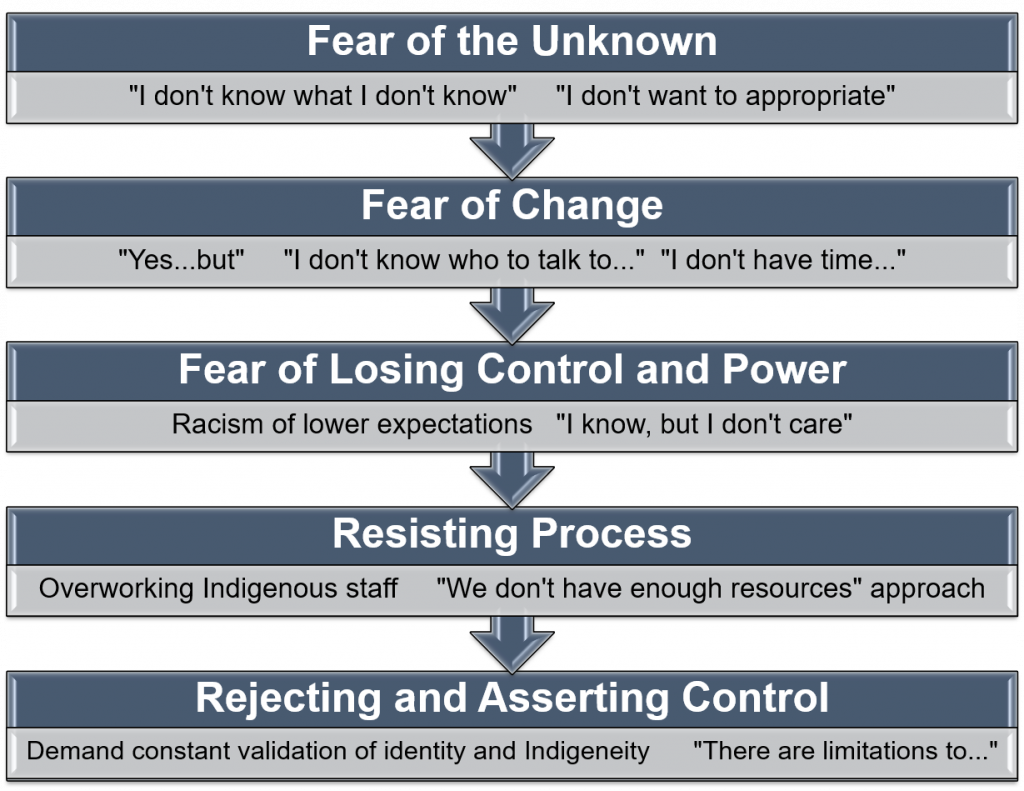22 Navigating the Levels of Indigenization
If you are at a point of Indigenizing your practice, you may still have to face fears and concerns. When developing the framework for the Indigenization project, the project steering committee considered the statements and instances where systemic change is not supported. The committee members then situated them in “levels of Indigenization.” These levels progress from fears to control and then rejection of Indigenization processes. They are not progressive levels, but they show that there are various levels of resistance and barriers to Indigenizing practice, field of study, and institutions.

Here are some strategies to keep in mind to help you overcome these challenges and barriers:
“I’m afraid to make a mistake”
- Do the emotional labour instead of being politically correct.
- Listen deeply.
- Trust that there are Indigenous people who have the skills to share with you and that you are willing to learn.
- Prepare yourself to conduct the appropriate protocols in their entirety and seek guidance.
- Include appropriate gestures/language of the land.
- Be kind to yourself.
- Ask yourself: What was the first or biggest mistake I made in the classroom? What were the consequences? What did I do?
- Approach with a “good mind and good heart”; be intentional to avoid tokenism.
“I am not Indigenous. Isn’t it appropriation?”
- Are you appropriating or being appropriate?
- Acknowledge (in your delivery) that others know much more than you; practise humility.
- Always ensure that you acknowledge and properly recognize the sources of your information.
- Be open to being “corrected” and willing to do more research.
- Use guest speakers.
- Practise reciprocity by being a guest speaker for Indigenous faculty you invite into your classroom.
- Ensure that the information and resources you use are authentic.
“I’ll do it if the university/college/institute gives me a course release”
- Indigenous perspectives and content are related to the original course outline.
- Indigenous and non-Indigenous students deserve to be taught this information to allow them to become respected citizens and understand their lived realities.
- In this era of reconciliation, Indigenizing is responsible practice and part of staying current.
- Indigenizing your course content and practice can go into your teaching portfolio, thus contributing to professional practice and tenure.
“I have 13 weeks to deliver all content and can’t include anything else”
- Start small; set some goals and objectives for your course to include Indigenous ways of learning, such as making a territorial acknowledgement and sharing why this is important to you with students.
- Identify some topics that could include local Indigenous communities and adapt your course to include local knowledge.
- Inter-culturalize your “lesson planning”; once you create the space it becomes a natural part of your course delivery.
- Ask yourself: What is my understanding of “Indigenizing”?
- It will take our very best thinking, but we are in the best position to do this thinking/creating.
“I can’t do this myself”
- Take personal responsibility for your teaching practice.
- Devote more professional development time to engaging with Indigenous content and perspectives.
- Meaningfully involve “authentic” scholars who devote their life to inclusive and generous learning.
- Be inclusive of all stakeholders in the area.
- Develop curriculum and policies together.
- You are not alone; you are supported by policy, colleagues, Indigenous people, and educators.
- Look for allies!
- Have a cup of coffee with an Elder or Indigenous instructor to develop a relationship as a start to Indigenize your course
- Read Indigenous Peoples’ writings in your discipline
- Attend Indigenous sections at discipline conferences
Long Descriptions
Fig 4.2 long description: Levels of resistance to Indigenization:
- Fear of the unknown: People saying, “I don’t know what I don’t know,” or “I don’t want to appropriate.”
- Fear of change: People saying, “Yes… but,” or “I don’t know who to talk to…,” or “I don’t have time.”
- Fear of losing control and power: Racism of lower expectations and people saying, “I know, but I don’t care.”
- Resisting process: Overworking Indigenous staff and people taking the “We don’t have enough resources” approach.
- Rejecting and asserting control: Demand constant validation of identity and Indigeneity and saying, “There are limitations to…”
Attributions
Fig 4.2: Levels of Indigenization by Indigenization Project Steering Committee is used under a CC BY 2.0 Generic Licence.

